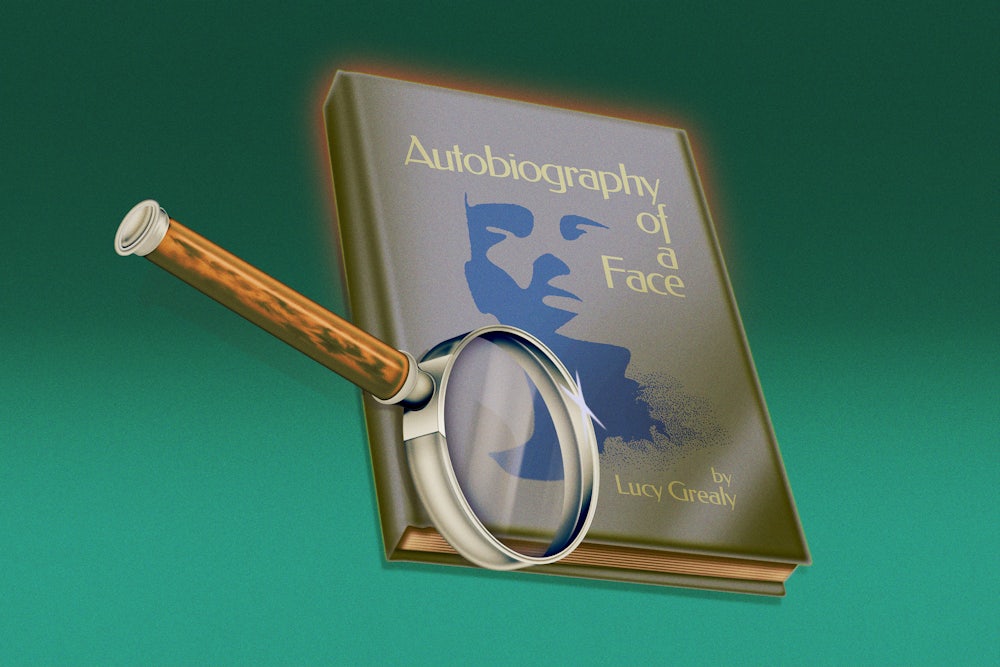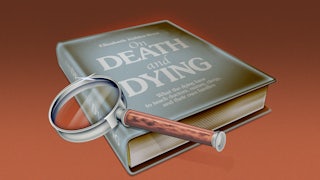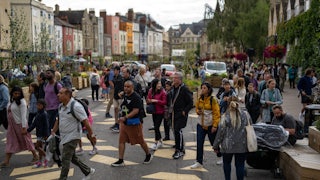I first learned about Lucy Grealy in Leslie Jamison’s The Empathy Exams. Grealy had written a book with a title that Jamison had, while an English student at Harvard in the early 2000s, imagined using for her own memoir: Autobiography of a Face. The fact that Jamison had not heard of Grealy’s 1994 hit suggests that it had, within just a few years of its publication, fallen into relative obscurity. Autobiography of a Face—which chronicles Grealy’s disfiguring childhood cancer and reconstructive facial surgeries—was, upon its release, a bestseller and the subject of interviews with Terry Gross, Charlie Rose, CNN, and the Today show. It was a sensation then and is a painfully resonant work in our image-obsessed, plastic surgery culture now.
And its legacy has been enriched by the literature it’s inspired—from Ann Patchett’s 2002 memoir of her friendship with Grealy to Jamison’s 2014 meditation on beauty and identity. Autobiography of a Face is ostensibly about isolation but has in fact become part of a larger story of literary collaboration and the boundaries between artists, friends, and their work.
Born in Dublin in 1963, Lucy Grealy moved with her family to upstate New York when she was 4. She developed Ewing’s sarcoma at the age of 9, and endured invasive procedures and radiation that left her with few teeth and only half a jaw. Grealy has a poet’s eye for the sensory experience of being sick. Pain “was an anatomy lesson,” she writes. Chemo taught her that “it was possible to feel your organs, feel them the way you feel your tongue in your mouth, or your teeth.” She opted for chocolate pudding over vanilla, because it looked better when she vomited it back up. She gave up orange juice, which tasted like “rinsing my mouth out with battery acid.”
The brilliance of Autobiography of a Face is in how it conveys a child’s logic—and pinpoints the precise moments when innocence yields to shame. When Grealy first learns that she is sick, she’s relieved: She won’t have to finish her book report. The hospital is “a great adventure,” even when she needs a four-hour surgery and a gastronasal tube. Her ordeal earns her attention from doctors and gifts from her parents; she is only disappointed that she doesn’t get to ride in an ambulance. When she goes home after a few weeks, now missing part of her jaw, she is “proud of my new, dramatic scar and eager to show it off.” At 10, she is happily oblivious to beauty standards and how she measures up; she has not yet learned to see herself as object. Even when she goes back to the hospital for chemo and her long, blonde hair begins to fall out, “I somehow ignored the change in my appearance.”
It’s the reactions of others—the kids in the parking lot who call her “Baldy” or “Dog Girl”—that bring it into focus. Even her mother’s well-intentioned efforts, predicated on the mistaken assumption that Lucy is insecure about her looks, backfire. When Lucy is 11, her mom takes her to an expensive wig shop in Rockland County, which mostly caters to married Orthodox women. Lucy thinks the whole excursion is “ludicrous” and is shocked when her mom, instead of making a joke about how silly the human-hair wigs look, offers to buy her one. “It was dawning on me that I might look much worse than I had supposed,” she writes. When she finally returns to school, sixth-grade bullies confirm her suspicion. It is devastating to watch her adopt “the habits of self-consciousness”: looking down; hiding her face behind her hand, and her thinning hair under a sailor’s hat; retreating into the world of horses and her own imagination.
The fact that Grealy could maintain her innocence until the age of 11 sounds, now, like some archaic luxury. In the 1970s, cameras were expensive equipment for special occasions. Grealy would come to dread being photographed—but she was basically able to avoid it by skipping school on picture day. How would she have coped with iPhone cameras? With Zoom? Would a contemporary Grealy ask her friends if she was pretty—or would she submit a picture of her face for online strangers to review, perhaps on a brutal forum like TrueRateMe?
Grealy’s medical treatments worked: Against the odds, she recovered from cancer. But she became obsessed with her asymmetrical face—and the possibility that it could be fixed. Throughout her adult life, she sought out drastic reconstructive operations. A balloon was inserted into her cheek and slowly inflated with saline; a bone was excised from her leg and grafted onto her jaw, leaving with her trouble walking. Grealy “never gave up believing that there would be a final moment, a last surgery, a point at which her ‘real life’ would begin,” writes Ann Patchett in her own memoir of her relationship with Grealy, Truth & Beauty: A Friendship.
In the meantime, Grealy felt profoundly alienated from her
physical self. “Maybe this wasn’t my actual face at all but the face of some
interloper,” she writes, full of hope after a young doctor tells her about a new,
experimental surgery. Later—after a particularly arduous series of
operations—she felt so estranged from her own reflection that, although she thought
her appearance had improved, “I
simply could not conceive of the image as belonging to me.”
The bulk of Grealy’s book concerns her childhood: her repetitive surgeries, her burgeoning self-consciousness, her adolescent loneliness. The final chapter rushes through her college and graduate school years—glossing over her sudden popularity and her discovery of her own writing talent, as though any admission of happiness or success might discredit her prior suffering. On page 189, she’s a bullied high school student; on page 203, she is dancing at gay clubs and partying with Andy Warhol. How?
In Truth & Beauty, the novelist Ann Patchett—her close friend of two decades—picks up the story where Grealy left off. Autobiography of a Face was published when Grealy was 31, and it brought her the literary fame she had longed for in her twenties. Truth & Beauty came out 10 years later—shortly after Grealy died of a heroin overdose.
Patchett and Grealy were classmates at Sarah Lawrence, but barely knew each other: Grealy was a campus celebrity, while Patchett—in her own telling, at least—had “a tendency to blur into other people.” But they wound up living together at the Iowa Writers Workshop, where Grealy studied poetry and Patchett wrote fiction, and quickly became inseparable—dancing, drinking, reading, sharing art and ideas until the boundaries between them collapsed. “We didn’t so much discuss our work as volley ideas back and forth until neither of us was sure who belonged to what,” Patchett writes. Separated after Iowa by postgrad jobs and Lucy’s sporadic hospital stays, they kept in touch with frequent phone calls, cross-continental visits, and long, extravagant letters, some of which are reprinted in Truth & Beauty. Ann calls Lucy her “pet,” and Lucy addresses Ann as “my little lamp on the wharf,” “my most loved hero,” “my self winding watch, my showpiece, my shoelace.” (There’s a writerly self-consciousness to the letters, as if both women hope they might one day be published.)
Patchett portrays Grealy as the grasshopper to her ant, the rabbit to her hare: as magnetic and irresponsible as she is dutiful and forgettable. The dynamic haunts their relationship—an imbalance baked into their earliest arrangement as roommates. Patchett was the more domestic of the two, and so, she writes, “The compromise was that I would do all the cleaning and cooking and that neither of us would complain about it, which suited both of us fine.” This does not sound like a sustainable compromise to me, but it seems to work for Patchett, who comes across as either a pushover or a saint. Over the years—as the disorganized Grealy cycles in and out of the hospital—Patchett’s devotion seems to have no bounds. She answers Grealy’s fan mail, tidies her apartment, and pays off her debts. When Grealy sells a novel, spends her hefty advance, and then struggles to complete the manuscript, Patchett offers to ghost-write it for her.
(The most dated thing about these books is the way Patchett and Grealy talk about the economics of writing. When Grealy considers going to med school in her late thirties, her idea for covering the tuition is to “write a few articles.” In the mid-1990s, for Patchett, “the easy money was in magazine articles and the sensible living was in writing books.” Today, the fees for magazine articles often add up to less than minimum wage; the sensible living is in choosing a different career.)
Patchett’s generosity is not always reciprocated. Grealy comes across as needy and often possessive—demanding that Patchett reassure her, in front of her other friends, that Grealy is her favorite; draping herself across Patchett’s lap at a literary prize ceremony. When Patchett falls in love with a poet, Grealy sulks. “Do you like his poetry better than mine?” she asks. “Do you love me more?” In an instance I find hard to imagine just moving on from, Grealy bans Patchett from working with an editor she likes, because Lucy had worked with her first.
Grealy’s memoir is a testament to the ego-muddling effects of having a face that’s perpetually in flux. Patchett draws a link between Grealy’s ever-shifting appearance and her inability to forge a stable identity. “In the course of most lifetimes, few people are capable of the kind of enormous changes that Lucy seemed to manage every year,” she writes. Patchett watched Lucy reinvent herself over and over: “shy and cool” at Sarah Lawrence; “scrappy and James Dean tough” at Iowa; “decked out in high heels and tiny black cocktail dresses” in New York. She saw her reveling in her short-lived literary fame; crushed by writer’s block (“I spend my entire life feeling guilty that I’m not writing”); and, finally, isolated and dependent on drugs.
Reading these two books back to back is an extraordinary experience: We see how Grealy’s self-perception clashes with the perception of others, and how her childhood insecurities persist, impervious to objective reality. After a classmate dismisses her suitability as a romantic prospect, 14-year-old Grealy “knew definitively that I would never have a boyfriend, that no one would ever be interested in me in that way.” In fact, we learn from Patchett, Grealy snagged a boyfriend as soon as she arrived at Iowa and developed an impressive list of conquests. Yet, in her twenties and thirties, she would often phone Patchett to ask: “Will I ever have sex again?” (No matter if she had already had sex that day.) Patchett doesn’t deny that Grealy’s jaw is irregular, or that her neck is scarred—but she also notices her friend’s “lovely light eyes” and “damp dark lashes,” her “white Irish skin and dark blond hair.” Even as Grealy’s appearance fluctuates, “In the end that’s what you saw, the things that didn’t change: her eyes, the sweetness of her little ears.”
One Sunday toward the end of her life, Grealy called Patchett from the hospital at 5:30 a.m: She wanted a bottle of apricot nectar. So Patchett pulled herself out of bed and went looking for one. She found peach nectar and strawberry banana shakes, but “Lucy had made it clear she wasn’t interested in substitutions.” She tracked it down at the eighth store. As Grealy spiraled into addiction and her mental health deteriorated, she became more erratic—but Patchett rose to meet her escalating demands.
“Mental health,” by the way, is not a term that appears in this book. I am drawing on the vernacular of the 2020s. If Patchett were writing today, she would no doubt use terms like “toxic,” perhaps even “emotional abuse.” But this is the story of a friendship that flourished before the notion of “boundaries” was in common parlance. I wondered, as I read, if this relationship would even be possible today—or if a therapist would tell Patchett to “distance herself,” or if her friends would encourage her to cut Grealy out of her life. I doubt Truth & Beauty would still be treated—as it was by most mid-2000s critics—as a tribute to love and commitment. “How much enabling can one person do in the name of friendship?” asks one recent Goodreads reviewer. Another calls this “a story of codependence.”
Grealy’s demands are sometimes shocking to read. But if the friendship was lopsided, it also fueled Patchett’s writerly imagination—inspiring a tribute that deepens Grealy’s work. Patchett has said that she wrote her book in order to bring new readers to Autobiography of a Face. “It’s my personal goal to make sure people keep reading her book,” she told Oprah Daily. But Truth & Beauty also stands on its own.






